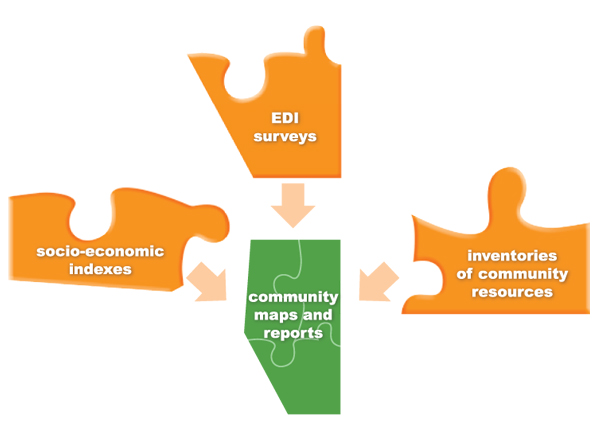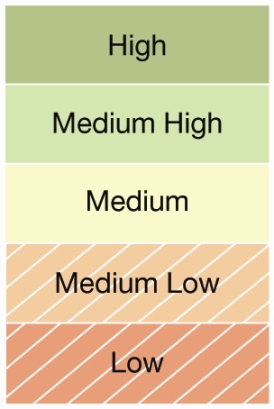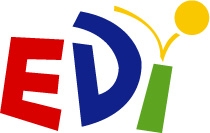What kind of research information was collected?

Three kinds of information was analyzed:
- Early Development Instrument (EDI) results,
- socio-economic status, and
- community assets.
Combining EDI results with information on socio-economic status and community resources and characteristics allows us not only to look at how children are developing but why they may be developing the way they are, whether they are doing well or having difficulties. Research shows that socio-economic and community factors can vary widely from one geographic area to another and have a great impact on child development.
The Early Development Instrument (EDI)
What is it?
The EDI is a standardized tool that measures the development of populations of five-year-old children. Kindergarten teachers fill out questionnaires on the development of each child in their classroom. The questionnaires are made up of 103 questions on children’s social, emotional, physical and intellectual development. The questions are based upon age-appropriate indicators of development, such as being able to hold a pencil to climbing stairs independently and following simple instructions. The results are then grouped together to provide population-based information, much like a census. Results are not reported individually. The EDI is not a diagnostic tool.
The EDI has been widely used across Canada and in other countries since it was first developed by the Offord Centre for Child Studies at McMaster University in Hamilton, Ontario in 1998. By 2004, the EDI had been used to gather information on nearly 300,000 kindergarten children across Canada.
What does the EDI tell us?
The EDI looks at five areas of development:
Physical health and well-being
- fine and gross motor skills (e.g. can hold a pen, crayons
or brush, able to climb stairs) - independence in looking after own needs (e.g. able to go
to the washroom independently most of the time) - physically prepared for school (e.g. dressed appropriately,
well nourished and rested) - able to sustain energy levels throughout the school day
Social competence
- plays and gets along with other children
- able to follow rules and instructions
- able to follow routines
- accepts responsibility for actions
- shows respect for others
Emotional maturity
- able to deal with feelings at an age-appropriate level
- able to separate from parent/guardian
- not too fearful, not too impulsive
- able to focus
Language and thinking skills
These relate to early academic skills, including:
- an interest in reading, writing and language-related activities
- age-appropriate reading, writing and counting skills
- recognition of shapes, sizes and colours
- can easily remember things
Communication skills and general knowledge
These relate to general communications skills and knowledge, including:
- ability to communicate needs and wants in socially appropriate ways
- ability to tell stories
- can say words clearly
- age-appropriate knowledge about life and the world
- ability to take part in imaginative play
Download a chart of the EDI and five areas of development.
How are EDI results described in Alberta?
The EDI scores of each child fall into one of three categories:
- developing appropriately,
- experiencing difficulty, and
- experiencing great difficulty.
The percentage of children falling into each category is determined by using the Canadian norm "cut-offs" established by the Offord Centre. These cut-offs are based on the EDI scores of about 175,000 children across Canada and are known as the national norm standards.
What do the categories mean?
Developing appropriately: includes scores that reflect most or all of the developmental skills and abilities usually demonstrated by the time children are in kindergarten; scores above the 25th percentile of the Canadian norm.
Experiencing difficulty: includes scores that indicate probably delays in some areas of development; scores between the 10th and 25th percentile of the Canadian norm.
Experiencing great difficulty: includes scores that suggest significant delays in development; scores below the 10th percentile of the Canadian norm
Are there any differences in how EDI terminology is used in Alberta and by the Offord Centre?
There are some differences:
- areas of development - Offord Centre: 'domains of development'
- language and thinking skills - Offord Centre: 'language and cognition'
- developing appropriately - Offord Centre: 'very ready', 'ready', 'on track', 'ready for school' and 'middle'
- experiencing difficulty - Offord Centre: 'at risk', 'not on track' and 'not ready'
- experiencing great difficulty - Offord Centre: 'vulnerable', 'not on track' and 'not ready for school'
How was EDI information collected in Alberta?
- The EDI was collected by school authorities across Alberta on a voluntary basis. School authorities included public and separate school boards, Francophone schools, charter schools, private schools and Early Childhood Service operators.
- Teachers obtained written consent from parents for their children to be included.
- Kindergarten teachers filled out a questionnaire for each child in February or March once they’ve had a chance to get to know their children. Children are not tested directly.
- Teachers received special training in filling out the questionnaires beforehand.
- Between 2009-2013, EDI information was collected at least twice by most of 135 school authorities and 1,100 schools across Alberta.
Were all kindergarten-aged children included in EDI results?
Kindergarten is not compulsory in Alberta, so not all children attend. The vast majority do, however. Questionnaires were excluded from analysis for the following reasons:
- The child was been in class for less than one month and was therefore not well known by the teacher.
- The survey was invalid because of missing information.
- The child was diagnosed with severe disabilities. EDI surveys for these children were not included because they are not included in the national norms for the EDI. Results for children with diagnosed special needs were analyzed separately.
- The child was under four years old or over seven years old.
How were results reported in Alberta?
EDI questionnaires were administered by school authorities, but the results were compiled according to where children lived. Results were grouped and reported at the community and subcommunity level, for the cities of Edmonton and Calgary, and provincewide.
Communities, or early childhood development (ECD) communities as they are called, set their own boundaries by working through their local coalitions. Once boundaries were established and EDI information was available, results were mapped for the community. In rural areas, a community may cover a large area and several villages and hamlets. In more urban areas, a community may cover one town. Alberta’s two major cities, Edmonton and Calgary, encompass numerous communities because of their population density and size. More detailed EDI information was also presented at the subcommunity level, wherever numbers warranted.
To ensure reliability, EDI results were only reported for communities and subcommunities. where a minimum of 30 usable questionnaires were collected and where the number of usable questionnaires represented at least 74 per cent of the children who were enrolled in kindergarten and resided in the area.
How many children were included in EDI results?
A total of 86,564 children were included in EDI data collection between 2009 and 2013. Out of all the questionnaires collected, 70,206 met the criteria for analysis and were usable.
Is there any relationship between EDI results and success in school?
The EDI is a general predictor of academic success. British Columbia began collecting EDI results in 1999 and was the first province to implement the EDI provincewide. Research in B.C. has shown a connection between EDI results in kindergarten and children's scores in later grades, according to the Human Early Learning Partnership (HELP). HELP, which is based at the University of British Columbia, analyzes and maps EDI data in B.C. It is too early to tell at this point whether a similar connection will be established in Alberta.
Socio-economic status
Social and economic conditions are part of the early environments that influence children’s development. A large body of research shows that poor socio-economic conditions increase the likelihood of child developmental difficulties.
What is SES?
SES (socio-economic status) describes the social and economic conditions of the people who live in a geographic area. It can include such things as average income, employment status, education levels, ethnic mix, types of housing and types of child care used by families. SES reflects the overall social and economic well-being of a particular area.
How was the SES measured by the ECMap project?
A measure of SES was based on 26 variables compiled from 2006 census data provided by Statistics Canada. Variables were chosen on the basis of their importance in explaining socio-economic status. The variables were then grouped into five factors through a process called factor analysis. The factors were weighted because some are more important in determining SES and are therefore given more weight in calculating SES.
Factors were weighted and added up into one number, known as the socio-economic index or SEI. An SEI score was calculated for different geographic areas, including communities and subcommunities. SEI scores in Alberta ranged from a low of 1 to a high of 100. A low SEI score indicates high social and economic disadvantages and a high SEI score indicates more economic and social advantages.
How was SES categorized and mapped?
SES was divided into five categories, according to SEI scores: high, medium high, medium, medium low and low. A high SEI is the most advantaged and a low is the most disadvantaged. The five categories are colour coded on maps as follows:

What are the five factors and 26 variables?
The five factors are: economic stability, social mobility, cultural similarity, vulnerability and child care. The five factors are made up of 26 variables. To find out more about the factors and variables, download this table.
Does the SEI take into account the different cost of living in communities in Alberta and how this may affect poverty levels for example?
Statistics Canada uses local data, including the cost of living, to calculate variables for different geographic areas. Low income cut-offs differ from one area to another and between urban and rural areas, for example.
What are community assets?
Communities shape the environments in which young children are raised and influence their development. Communities can help to create the safe, enriching environments that promote positive development. Community assets are the things in the community that positively influence development and are valued by community members. They include:
- community features - natural (parks, forests, rivers and hills) or built (recreation centres, libraries, places of worship, playgrounds, walkways, etc.),
- community characteristics - such as social and economic circumstances, population density, types of industrial activity, social cohesion and the histories and cultures of a community, and
- community resources - services, programs, people, organizations and activities that affect or may have the potential to affect child development.
Communities, working through their coalitions, played an important role in gathering information about community assets. A tool kit was developed by ECMap to assist communities in this process. By the spring of 2014, community coalitions throughout Alberta identified and mapped a total of 23,106 assets and resources in their communities.
For more information on community assets, please download the Information Sheet.
Putting it all together
Information on the EDI, SES and community resources was summarized in graphics, maps and reports compiled for communities and their subcommunities, and the province as a whole. Mapping is a particularly useful tool in presenting complex information in a simple visual format.
This population-based approach to early development has enabled Albertans to:
- see how children are doing across Alberta,
- consider the similarities and differences among communities and regions,
- across the province and nationally,
- track trends over time,
- reveal strengths and weaknesses in development and where improvement is needed,
- identify gaps in supports and services,
- gain insights into how socio-economic factors are influencing development, and
- plan and work more effectively at all levels to improve development.
For further information
Resources
The Early Development Instrument: Benefits to Children, Families and Communities. This brief video (8 min.) explains why the EDI is an important tool and how it works. The video was produced by the Human Early Learning Partnership at the University of British Columbia and features interviews with Dr. Clyde Hertman, HELP director, kindergarten teachers, a school superintendent and community members.
http://www.youtube.com/watch?v=QMrxdzKYIYw&feature=related
Find out more about the Offord Centre.
Download a copy of the EDI 2011-12 questionnaire for Alberta.

